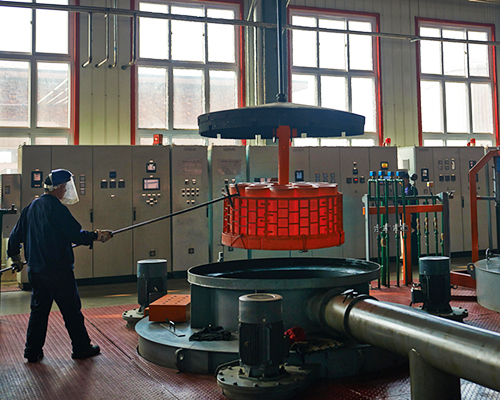Well type furnace manufacturer tells you the process operation and precautions of ion nitriding
1. Parts treated in the same furnace shall be of the same type or with similar surface area to mass ratio. The distance between the parts and the anode shall be approximately equal and more than 30mm. The distance between the parts shall be large enough and uniform. The auxiliary cathode or anode shall be placed at the lower position of the parts. The temperature shall be considered when placing the sample, and the sample shall be as consistent as possible with the parts.
2. 1~4mm hole groove on the part is easy to cause arcing, ф 4~ ф The 10mm hole slot will cause uneven temperature, and the rusted parts can only be put into the furnace after being cleaned.
3. After the parts are loaded into the furnace, seal the furnace cover and vent nozzle, and connect the cathode and anode wires. Preheat and calibrate the vacuum gauge, and the ammonia thermal decomposition furnace shall be heated in advance.
4. Start the vacuum pump to make the furnace reach the required vacuum degree gradually, and open the gas valve to fill in a small amount of thermal decomposition ammonia, so that the furnace pressure is about 1.3~13.3Pa.
5. Close the high-voltage switch and slowly increase the voltage to make the parts glow. At the beginning of the cleaning phase, it is generally advisable to use low pressure and low current, high voltage and high grade current limiting resistors. The cleaning phase is normally a diffusion arc. However, the parts are improperly clamped, poorly contacted, the small hole groove is not shielded, and the surface has massive oil contamination. The insulation causes local arc damage to the parts, and the arc is still striking 1~2h after the lighting up, indicating that it is abnormal. The cause should be analyzed or the furnace should be shut down.

6. After the arc breaking and cleaning is completed, the heating stage will be started. The NH3 supply will be gradually increased, and the current and voltage will be increased to accelerate the temperature rise. The deformation of precision parts is strictly required, and the temperature rise speed is less than 100C/h. When the temperature rises to 200~400 ℃, the oil volatilization in the holes and slots will also cause arcing. The arcing points are concentrated around the holes and slots, and the arcing is intermittent. At this time, the voltage and air pressure can be appropriately reduced to reduce the arcing current. After the oil volatilizes completely, the arcing will stop.
7. If there is no sign of stopping arc striking at a certain position, the air pressure can be adjusted, and it can be judged whether the high air pressure without arc striking can maintain the need for temperature rise and insulation of parts. If the insulation can be maintained, continue nitriding. If not, stop the pump, open the furnace, remove the arc striking source, and then vacuum again for temperature rise.
8. When the furnace shell temperature rises to 35 ℃, start to supply cooling water, and the outlet temperature of cooling water shall be lower than 55 ℃.
9. During temperature rise, the flow of input gas shall be continuously increased or the air extraction rate shall be reduced or the air pressure shall be increased as the temperature rises. The temperature rise time is usually controlled at 0.5~3h, and the current density during temperature rise shall be controlled at 4~5Ma/cm.
10. At the heat preservation stage, the current density is smaller than that at the temperature rise. The current density can be fixed and the working temperature can be stabilized by adjusting the air pressure, voltage, ammonia decomposition temperature, etc. At this time, the heat preservation time shall be determined according to the process. The temperature is 500~540 ℃, the current density is 2/3 of the temperature rise, the air pressure is 500~800Pa, and the thickness of the glow layer is 2~5mm.
11. After the insulation is completed, power can be cut off. Close the air inlet valve, butterfly valve, pump, instrument and ammonia vaporizer. When the furnace shell temperature is lower than 25 ℃, turn off the cooling water.
12. The parts shall be naturally cooled in the furnace. In order to ensure that the surface of the parts will not produce oxidation color, after the power is cut off, the furnace shall be kept in a vacuum state and cooled to about 150 ℃. The furnace shall be opened for air cooling, and the non nitrided parts shall be coated with oil for rust prevention.
13. In order to improve the utilization rate of equipment, ventilation cooling or glow cooling method can also be used, that is, high voltage, low pressure and small current can be used to maintain the thin glow of the workpiece within half an hour before the end of the heat preservation stage. After the heating is stopped, cooling water can continue to be supplied, and a large amount of ammonia can be supplied (to accelerate the cooling speed).
14. The deformed out of tolerance parts shall be partially or wholly heated and straightened at a temperature lower than the nitriding temperature.
15. If there are blue, purple and other oxidation colors on the surface of the part, the air can be pumped again, and the cathode sputtering can be generated on the surface of the workpiece with low current, low pressure and high voltage, and the oxidation color can disappear after tens of minutes.
If you want to know more about the well type nitriding furnace, please continue to follow our website, and we look forward to your call.